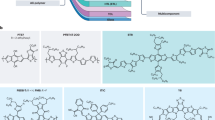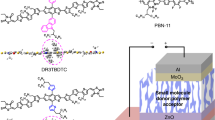Abstract
At present, state-of-the-art single-junction organic photovoltaic devices have power conversion efficiencies of >9% and >8% for polymer- and small-molecule-based devices, respectively. Here, we report a solution-processed organic photovoltaic device based on DRCN7T, which employs an oligothiophene-like small molecule with seven conjugation units as the backbone and 2-(1,1-dicyanomethylene)rhodanine as the terminal unit. With [6,6]-phenyl C71-butyric acid methyl ester (PC71BM) as the acceptor, an optimized power conversion efficiency of 9.30% (certified at 8.995%) is achieved. The DRCN7T-based devices have a nearly 100% internal quantum efficiency, which we believe is due to an optimized nanoscale interpenetrating donor/acceptor network (with highly crystalline donor fibrils with diameters of ∼10 nm, close to the exciton diffusion length in organic materials) and the use of an efficient electron transport layer.
This is a preview of subscription content, access via your institution
Access options
Subscribe to this journal
Receive 12 print issues and online access
$209.00 per year
only $17.42 per issue
Buy this article
- Purchase on Springer Link
- Instant access to full article PDF
Prices may be subject to local taxes which are calculated during checkout




Similar content being viewed by others
References
He, Z. C. et al. Enhanced power-conversion efficiency in polymer solar cells using an inverted device structure. Nature Photon. 6, 591–595 10.1038/nphoton.2012.190(2012).
Liao, S. H., Jhuo, H. J., Cheng, Y. S. & Chen, S. A. Fullerene derivative-doped zinc oxide nanofilm as the cathode of inverted polymer solar cells with low-bandgap polymer (PTB7-Th) for high performance. Adv. Mater. 25, 4766–4771 (2013).
You, J. et al. A polymer tandem solar cell with 10.6% power conversion efficiency. Nature Commun. 4, 1446 (2013).
Coughlin, J. E., Henson, Z. B., Welch, G. C. & Bazan, G. C. Design and synthesis of molecular donors for solution-processed high-efficiency organic solar cells. Acc. Chem. Res. 47, 257–270 (2013).
Chen, Y., Wan, X. & Long, G. High performance photovoltaic applications using solution-processed small molecules. Acc. Chem. Res. 46, 2645–2655 (2013).
Mishra, A. & Bäuerle, P. Small molecule organic semiconductors on the move: promises for future solar energy technology. Angew. Chem. Int. Ed. 51, 2020–2067 (2012).
Zhou, J. et al. Solution-processed and high-performance organic solar cells using small molecules with a benzodithiophene unit. J. Am. Chem. Soc. 135, 8484–8487 (2013).
Kyaw, A. K. K. et al. Improved light harvesting and improved efficiency by insertion of an optical spacer (ZnO) in solution-processed small-molecule solar cells. Nano Lett. 13, 3796–3801 (2013).
Liu, Y. et al. Solution-processed small-molecule solar cells: breaking the 10% power conversion efficiency. Sci. Rep. 3, 3356 (2013).
Heliatek. Heliatek consolidates its technology leadership by establishing a new world record for organic solar technology with a cell efficiency of 12%. Available at http://www.heliatek.com/wp-content/uploads/2013/01/130116_PR_Heliatek_achieves_record_cell_effiency_for_OPV.pdf. (January, 2013).
Steinmann, V. et al. Simple, highly efficient vacuum-processed bulk heterojunction solar cells based on merocyanine dyes. Adv. Energy Mater. 1, 888–893 (2011).
Sun, Y. et al. Solution-processed small-molecule solar cells with 6.7% efficiency. Nature Mater. 11, 44–48 (2012).
Walker, B., Kim, C. & Nguyen, T.-Q. Small molecule solution-processed bulk heterojunction solar cells. Chem. Mater. 23, 470–482 (2010).
Jorgensen, M., Norrman, K. & Krebs, F. C. Stability/degradation of polymer solar cells. Sol. Energy Mater. Sol. Cells 92, 686–714 (2008).
Blom, P. W., Mihailetchi, V. D., Koster, L. J. A. & Markov, D. E. Device physics of polymer: fullerene bulk heterojunction solar cells. Adv. Mater. 19, 1551–1566 (2007).
Roncali, J. Molecular bulk heterojunctions: an emerging approach to organic solar cells. Acc. Chem. Res. 42, 1719–1730 (2009).
Liang, Y. & Yu, L. A new class of semiconducting polymers for bulk heterojunction solar cells with exceptionally high performance. Acc. Chem. Res. 43, 1227–1236 (2010).
Zhou, H., Yang, L. & You, W. Rational design of high performance conjugated polymers for organic solar cells. Macromolecules 45, 607–632 (2012).
Li, Y. Molecular design of photovoltaic materials for polymer solar cells: toward suitable electronic energy levels and broad absorption. Acc. Chem. Res. 45, 723–733 (2012).
Lin, Y., Li, Y. & Zhan, X. Small molecule semiconductors for high-efficiency organic photovoltaics. Chem. Soc. Rev. 41, 4245–4272 (2012).
Brabec, C. J., Heeney, M., McCulloch, I. & Nelson, J. Influence of blend microstructure on bulk heterojunction organic photovoltaic performance. Chem. Soc. Rev. 40, 1185–1199 (2011).
Liu, F. et al. Characterization of the morphology of solution-processed bulk heterojunction organic photovoltaics. Prog. Polym. Sci. 38, 1990–2052 (2013).
Chen, L.-M., Xu, Z., Hong, Z. & Yang, Y. Interface investigation and engineering—achieving high performance polymer photovoltaic devices. J. Mater. Chem. 20, 2575–2598 (2010).
Yip, H.-L. & Jen, A. K. Y. Recent advances in solution-processed interfacial materials for efficient and stable polymer solar cells. Energy Environ. Sci. 5, 5994–6011 (2012).
He, Z., Wu, H. & Cao, Y. Recent advances in polymer solar cells: realization of high device performance by incorporating water/alcohol soluble conjugated polymers as electrode buffer layer. Adv. Mater. 26, 1006–1024 (2014).
Kyaw, A. K. K. et al. Efficient solution processed small molecule solar cells with inverted structure. Adv. Mater. 25, 2397–2402 (2013).
Li, X. et al. Dual plasmonic nanostructures for high performance inverted organic solar cells. Adv. Mater. 24, 3046–3052 (2012).
Dou, L. et al. 25th anniversary article: A decade of organic/polymeric photovoltaic research. Adv. Mater. 25, 6642–6671 (2013).
Li, Z. et al. Solution processable rhodanine-based small molecule organic photovoltaic cells with a power conversion efficiency of 6.1%. Adv. Energy Mater. 2, 74–77 (2012).
Proctor, C. M., Kuik, M. & Nguyen, T.-Q. Charge carrier recombination in organic solar cells. Prog. Polym. Sci. 38, 1941–1960 (2013).
Mao, J. et al. Stable dyes containing double acceptors without COOH as anchors for highly efficient dye-sensitized solar cells. Angew. Chem. Int. Ed. 124, 10011–10014 (2012).
Kuo, M. Y., Chen, H. Y. & Chao, I. Cyanation: providing a three in one advantage for the design of n-type organic field-effect transistors. Chem. Eur. J. 13, 4750–4758 (2007).
Brédas, J.-L., Beljonne, D., Coropceanu, V. & Cornil, J. Charge-transfer and energy-transfer processes in π-conjugated oligomers and polymers: a molecular picture. Chem. Rev. 104, 4971–5004 (2004).
Park, S. H. et al. Bulk heterojunction solar cells with internal quantum efficiency approaching 100%. Nature Photon. 3, 297–302 (2009).
Pettersson, L. A., Roman, L. S. & Inganas, O. Modeling photocurrent action spectra of photovoltaic devices based on organic thin films. J. Appl. Phys. 86, 487–496 (1999).
Peumans, P., Yakimov, A. & Forrest, S. R. Small molecular weight organic thin-film photodetectors and solar cells. J. Appl. Phys. 93, 3693–3723 (2003).
He, Z. C. et al. Simultaneous enhancement of open-circuit voltage, short-circuit current density, and fill factor in polymer solar cells. Adv. Mater. 23, 4636–4643 (2011).
Long, G. et al. Impact of the electron-transport layer on the performance of solution-processed small-molecule organic solar cells. ChemSusChem 7, 2358–2364 (2014).
Mandoc, M. M., Veurman, W., Koster, L. J. A., de Boer, B. & Blom, P. W. Origin of the reduced fill factor and photocurrent in MDMO-PPV:PCNEPV all polymer solar cells. Adv. Funct. Mater. 17, 2167–2173 (2007).
Proctor, C. M., Kim, C., Neher, D. & Nguyen, T.-Q. Nongeminate recombination and charge transport limitations in diketopyrrolopyrrole-based solution-processed small molecule solar cells. Adv. Funct. Mater. 23, 3584–3594 (2013).
Guerrero, A. et al. Solution-processed small molecule:fullerene bulk-heterojunction solar cells: impedance spectroscopy deduced bulk and interfacial limits to fill-factors. Phys. Chem. Chem. Phys. 15, 16456–16462 (2013).
Lenes, M., Morana, M., Brabec, C. J. & Blom, P. W. Recombination limited photocurrents in low bandgap polymer/fullerene solar cells. Adv. Funct. Mater. 19, 1106–1111 (2009).
Mozer, A. J. et al. Charge transport and recombination in bulk heterojunction solar cells studied by the photoinduced charge extraction in linearly increasing voltage technique. Appl. Phys. Lett. 86, 112104 (2005).
Li, W. et al. Effect of the fibrillar microstructure on the efficiency of high molecular weight diketopyrrolopyrrole-based polymer solar cells. Adv. Mater. 26, 1565–1570 (2014).
Guo, X. G. et al. Polymer solar cells with enhanced fill factors. Nature Photon. 7, 825–833 (2013).
Chen, D., Liu, F., Wang, C., Nakahara, A. & Russell, T. P. Bulk heterojunction photovoltaic active layers via bilayer interdiffusion. Nano Lett. 11, 2071–2078 (2011).
Acknowledgements
The authors acknowledge financial support from the Ministry of Science and Technology of China (MoST, 2014CB643502 and 2012CB933401), the National Natural Science Foundation of China (NSFC, 51373078) and the Program for Changjiang Scholars and Innovative Research Team in University (PCSIRT, IRT1257). The morphological characterization of the active layers was supported by the DOE-funded Energy Frontier Research Center on Polymer-Based Materials for Harvesting Solar Energy (DE-SC0001087). Portions of this research were carried out at the Advanced Light Source, Berkeley National Laboratory, which was supported by the DOE, Office of Science and Office of Basic Energy Sciences. The authors also acknowledge Beamline BL14B1 (Shanghai Synchrotron Radiation Facility) for providing beam time.
Author information
Authors and Affiliations
Contributions
Y.C., Q.Z. and X.W. proposed and designed the project and Y.C. and X.W. directed the study. Q.Z. and M.L. fabricated and characterized the devices. B.K. synthesized most of the donor materials with help from W.N., Y.Z. and H.Z. F.L. and T.R. performed and analysed the GIXD and RSoXS film characterization. G.K. and M.Z. performed the DFT calculations and the optical simulations. X.C. and Z.L. performed the experiments on refractive index n and extinction coefficient k and photo-CELIV. Z.H., F.H. and Y.C. provided the PFN materials. All authors discussed the results and commented on the manuscript.
Corresponding author
Ethics declarations
Competing interests
A patent (application no. CN2014100099426) has been filed for the materials and devices.
Supplementary information
Supplementary information
Supplementary information (PDF 3921 kb)
Rights and permissions
About this article
Cite this article
Zhang, Q., Kan, B., Liu, F. et al. Small-molecule solar cells with efficiency over 9%. Nature Photon 9, 35–41 (2015). https://doi.org/10.1038/nphoton.2014.269
Received:
Accepted:
Published:
Issue Date:
DOI: https://doi.org/10.1038/nphoton.2014.269
This article is cited by
-
Driving force and nonequilibrium vibronic dynamics in charge separation of strongly bound electron–hole pairs
Communications Physics (2023)
-
Efficient screening framework for organic solar cells with deep learning and ensemble learning
npj Computational Materials (2023)
-
Computational Study of New Small Molecules based Thiophene as Donor Materials for Bulk Heterojunction Photovoltaic Cells
Journal of Fluorescence (2023)
-
Seeing structural evolution of organic molecular nano-crystallites using 4D scanning confocal electron diffraction (4D-SCED)
Nature Communications (2022)
-
Charge transport studies of highly stable diketopyrrolopyrrole-based molecular semiconductor
Bulletin of Materials Science (2022)



